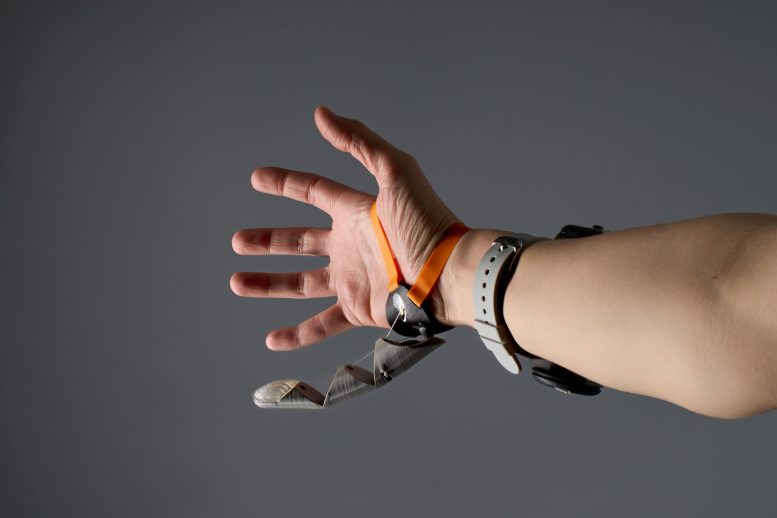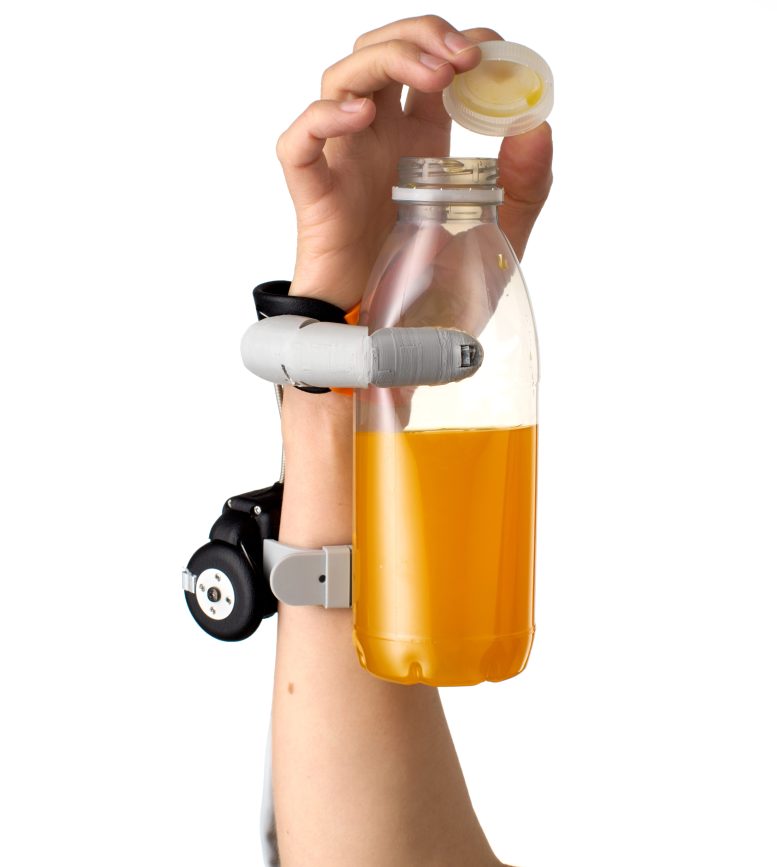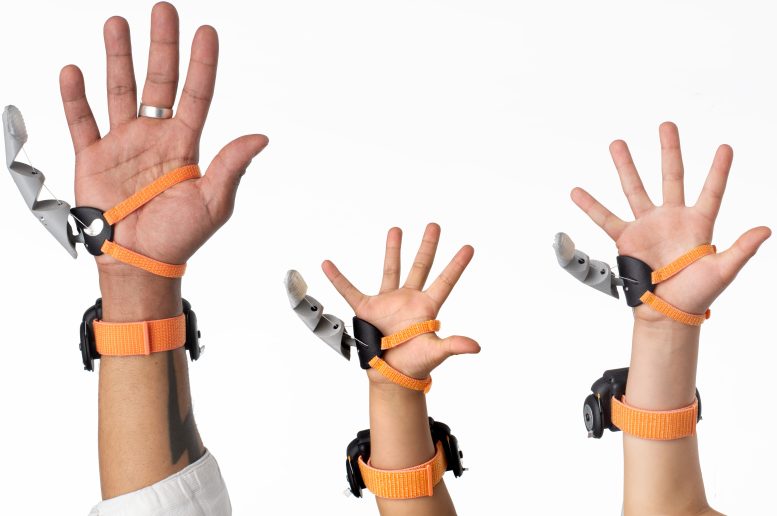
Cambridge researchers developed a controllable prosthetic extra thumb that people can quickly learn to use for picking up and manipulating objects. Testing at the Royal Society Summer Science Exhibition showed that the device is accessible to a wide demographic, with 98% of participants successfully using it within a minute. The study highlights the importance of inclusive design in technology, ensuring accessibility for all users, including marginalized communities. Credit: Dani Clode Design & The Plasticity Lab
Researchers at Cambridge have shown that the Third Thumb, a robotic prosthetic, can be quickly mastered by the public, enhancing manual dexterity. The study stresses the importance of inclusive design to ensure technologies benefit everyone, with significant findings on performance across different demographics.
Cambridge researchers demonstrated that people can rapidly learn to control a prosthetic extra thumb, known as a “third thumb,” and use it effectively to grasp and handle objects.
The team tested the robotic device on a diverse range of participants, which they say is essential for ensuring new technologies are inclusive and can work for everyone.
An emerging area of future technology is motor augmentation – using motorized wearable devices such as exoskeletons or extra robotic body parts to advance our motor capabilities beyond current biological limitations.
While such devices could improve the quality of life for healthy individuals who want to enhance their productivity, the same technologies can also provide people with disabilities with new ways to interact with their environment.
Professor Tamar Makin from the Medical Research Council (MRC) Cognition and Brain Sciences Unit at the University of Cambridge said: “Technology is changing our very definition of what it means to be human, with machines increasingly becoming a part of our everyday lives, and even our minds and bodies.
“These technologies open up exciting new opportunities that can benefit society, but it’s vital that we consider how they can help all people equally, especially marginalized communities who are often excluded from innovation research and development. To ensure everyone will have the opportunity to participate and benefit from these exciting advances, we need to explicitly integrate and measure inclusivity during the earliest possible stages of the research and development process.”
Dani Clode, a collaborator within Professor Makin’s lab, has developed the Third Thumb, an extra robotic thumb aimed at increasing the wearer’s range of movement, enhancing their grasping capability, and expanding the carrying capacity of the hand. This allows the user to perform tasks that might be otherwise challenging or impossible to complete with one hand or to perform complex multi-handed tasks without having to coordinate with other people.
Development and Functionality of the Third Thumb
The Third Thumb is worn on the opposite side of the palm to the biological thumb and controlled by a pressure sensor placed under each big toe or foot. Pressure from the right toe pulls the Thumb across the hand, while the pressure exerted with the left toe pulls the Thumb up toward the fingers. The extent of the Thumb’s movement is proportional to the pressure applied, and releasing pressure moves it back to its original position.
In 2022, the team had the opportunity to test the Third Thumb at the annual Royal Society Summer Science Exhibition, where members of the public of all ages were able to use the device during different tasks. The results are published today in Science Robotics.
Over the course of five days, the team tested 596 participants, ranging in age from three to 96 years old and from a wide range of demographic backgrounds. Of these, only four were unable to use the Third Thumb, either because it did not fit their hand securely, or because they were unable to control it with their feet (the pressure sensors developed specifically for the exhibition were not suitable for very lightweight children).
Participants were given up to a minute to familiarise themselves with the device, during which time the team explained how to perform one of two tasks.
The first task involved picking up pegs from a pegboard one at a time with just the Third Thumb and placing them in a basket. Participants were asked to move as many pegs as possible in 60 seconds. 333 participants completed this task.
The second task involved using the Third Thumb together with the wearer’s biological hand to manipulate and move five or six different foam objects. The objects were of various shapes that required different manipulations to be used, increasing the dexterity of the task. Again, participants were asked to move as many objects as they could into the basket within a maximum of 60 seconds. 246 participants completed this task.
Almost everyone was able to use the device straight away. 98% of participants were able to successfully manipulate objects using the Third Thumb during the first minute of use, with only 13 participants unable to perform the task.
Performance Insights Across Demographics
Ability levels between participants were varied, but there were no differences in performance between genders, nor did handedness change performance – despite the Thumb always being worn on the right hand. There was no definitive evidence that people who might be considered ‘good with their hands’ – for example, they were learning to play a musical instrument, or their jobs involved manual dexterity – were any better at the tasks.
Older and younger adults had a similar level of ability when using the new technology, though further investigation just within the older adults age bracket revealed a decline in performance with increasing age. The researchers say this effect could be due to the general degradation in sensorimotor and cognitive abilities that are associated with aging and may also reflect a generational relationship to technology.
Performance was generally poorer among younger children. Six out of the 13 participants who could not complete the task were below the age of 10 years old, and of those who did complete the task, the youngest children tended to perform worse compared to older children. But even older children (aged 12-16 years) struggled more than young adults.
Dani said: “Augmentation is about designing a new relationship with technology—creating something that extends beyond being merely a tool to becoming an extension of the body itself. Given the diversity of bodies, it’s crucial that the design stage of wearable technology is as inclusive as possible. It’s equally important that these devices are accessible and functional for a wide range of users. Additionally, they should be easy for people to learn and use quickly.”
Co-author Lucy Dowdall, also from the MRC Cognition and Brain Science Unit, added: “If motor augmentation – and even broader human-machine interactions – are to be successful, they’ll need to integrate seamlessly with the user’s motor and cognitive abilities. We’ll need to factor in different ages, genders, weight, lifestyles, disabilities – as well as people’s cultural, financial backgrounds, and even likes or dislikes of technology. Physical testing of large and diverse groups of individuals is essential to achieve this goal.”
There are countless examples of where a lack of inclusive design considerations has led to technological failure:
- Automated speech recognition systems that convert spoken language to text have been shown to perform better listening to white voices over Black voices.
- Some augmented reality technologies have been found to be less effective for users with darker skin tones.
- Women face a higher health risk from car accidents, due to car seats and seatbelts being primarily designed to accommodate ‘average’ male-sized dummies during crash testing.
- Hazardous power and industrial tools designed for a right-hand dominant use or grip have resulted in more accidents when operated by left-handers forced to use their non-dominant hand.
Reference: “Evaluating initial usability of a hand augmentation device across a large and diverse sample” by Dani Clode, Lucy Dowdall, Edmund da Silva, Klara Selén, Dorothy Cowie, Giulia Dominijanni and Tamar R. Makin, 29 May 2024, Science Robotics.
DOI: 10.1126/scirobotics.adk5183
This research was funded by the European Research Council, Wellcome, the Medical Research Council and Engineering and Physical Sciences Research Council.











“There are countless examples of where a lack of inclusive design considerations has led to technological failure: …”
“Failure” is not defined, and there is no proof provided for the assertion that “inclusive design considerations” are responsible for technologies not living up to unstated expectations. If a new technology allows humans to do things they formerly couldn’t, then it is not a “failure.” It just may be sub-optimal.